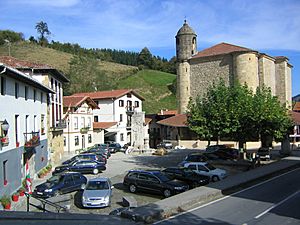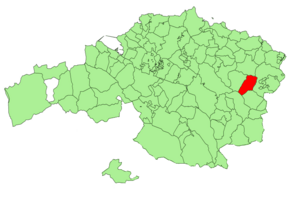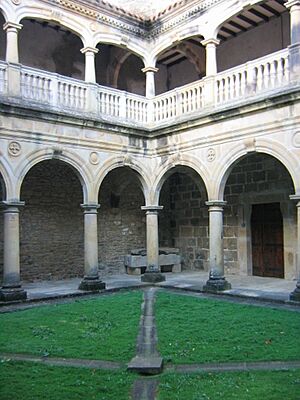Ziortza-Bolibar facts for kids
Quick facts for kids
Ziortza-Bolibar
|
|||
|---|---|---|---|
| Ziortza-Bolibar | |||
 |
|||
|
|||

Location of Ziortza-Bolibar in Spain and Biscay
|
|||
| Country | |||
| Autonomous community | |||
| Province | Biscay | ||
| Comarca | Lea-Artibai | ||
| Founded | 2005 | ||
| Area | |||
| • Total | 18.50 km2 (7.14 sq mi) | ||
| Elevation | 162 m (531 ft) | ||
| Population
(2018)
|
|||
| • Total | 427 | ||
| • Density | 23.08/km2 (59.78/sq mi) | ||
| Demonym(s) | Ziortzarra Bolibartarra | ||
| Time zone | UTC+1 (CET) | ||
| • Summer (DST) | UTC+2 (CEST) | ||
| Postal code |
48278
|
||
Ziortza-Bolibar is a small town in the Biscay province of the Basque Country, Spain. It is part of the Lea-Artibai region. In 2006, about 383 people lived there. The town covers an area of 18.94 square kilometers.
This municipality became independent again on January 1, 2005. Before that, since 1969, it was part of another town called Markina-Xemein. Records show that Ziortza-Bolibar has existed since the 11th century.
Contents
Understanding the Name: Ziortza-Bolibar
The name Bolibar comes from the Basque language. It means "windmill valley." The word bolu means "windmill," and ibar means "valley."
The name Ziortza (or Cenarruza) comes from a local plant called ziaurri, which is a type of polygonum. The ending -tza means a place where there is a lot of something. So, Ziortza means "a place with many ziaurri plants."
Discovering Puebla de Bolívar
Bolívar (or Bolibar in Basque) is the main part of the town. It is located next to a stream, at the base of Oiz Mountain.
How Bolívar Regained Independence
From 1969 to 2004, Bolívar and the nearby area of Cenarruza (Ziortza) were part of the Markina-Xemein municipality. However, people in the community worked together. They managed to make both areas a single, independent municipality once more.
Simón Bolívar's Family Roots
The famous last name Bolívar started in this very place! A colonist named Simón Bolívar de la Rementería was born here. He took the name from Europe to the Americas. His famous descendant, Simón Bolívar, became known as one of the Libertadores (Liberators) of America. He is famous worldwide for helping many South American countries gain independence.
In Ziortza-Bolibar, there are two statues and a museum honoring Simón Bolívar. His family's old house, called Rementería, used to be behind the local church, but it is no longer there.
Important People from Bolívar
This small village has been home to other important figures:
- Diego de Irusta: He fought in the Battle of Las Navas de Tolosa.
- Bernardino de Irusta: He was an abbot (a leader) at the Collegiate Church of Cenarruza.
- General Francisco de Longa: He was a hero during the Spanish Independence War.
- General Pedro de Zubiaur: Another notable general from the area.
Exploring the Collegiate Church of Cenarruza
The Collegiate Church of Cenarruza (or Ziortza) is about two kilometers from the main town. It was a very important stop on the Route of Santiago de Compostela. This was a famous pilgrimage route. The church's influence went beyond just religious matters.
The Legend of the Eagle and the Skull
People believe the church was founded in the 10th century. A legend says that on a special day in 968, locals were at a church in Garay. An eagle picked up a skull from an open tomb. It then dropped the skull exactly where the Collegiate Church stands today. People saw this as a sign from above. They decided to build the religious complex in that very spot.
Parts of the Church Complex
The Collegiate Church complex includes several interesting parts:
- The Church: It was first built in the 14th century. It was rebuilt many times until the 15th century. That's when it got its current Gothic style. Inside, there is a beautiful old organ, one of the oldest in Biscay. You can also see many sculptures. The entrance (portico) has cool carvings on its beams. The front door has sculptures of Jesus Christ and two angels playing music.
- The Cloister: This peaceful area was built during the Renaissance period. It has a square shape. The spaces between the arches (spandrels) are decorated with shells and Fleur-de-lis crosses.
- The Eastern Gate: This is the main entrance to the church complex. It has the coat-of-arms of the Múgica and Butrón families. You can also see an image of the legendary eagle holding the skull in its claws.
- The Western Gate: This gate is smaller than the Eastern one. But it has the same family coats-of-arms and the same image of the eagle with the skull.
There used to be a hospital for pilgrims here. It was destroyed in a fire. Later, it was rebuilt as a hostel. Cistercian monks from the Oliva monastery in Navarra now manage it. You can still see parts of a walkway that was once part of the Santiago Route.
Other Important Sights in Bolívar
- Church of Saint Thomas: This church was first built in the 10th century. It was rebuilt in the 17th and 18th centuries. It looks a bit like a fortress-temple. It has one main room (nave) and a special arched ceiling (rib vault). There are also two round towers. The altar is in a neoclassical style.
- Monument to Simón Bolívar: In 1927, the government of Venezuela built a monument here. It honors Simón Bolívar, the "Liberator." This was the first monument to him in all of Spain.
See also
 In Spanish: Cenarruza-Puebla de Bolívar para niños
In Spanish: Cenarruza-Puebla de Bolívar para niños







